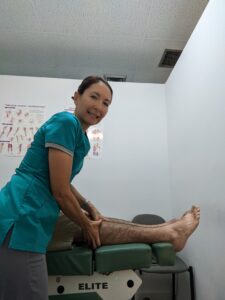
There is a common misconception that chiropractors are just spine doctors. However, from the very beginning, chiropractic adjustments have been delivered to the nonspinal joints as well. The nonspinal joints include the temporamandibular (TMJ), shoulder, elbow, wrist, hand, hip, knee, ankle and foot. For example, D.D. Palmer, the founder of the chiropractic profession described his treatment of the feet in 1910. In fact, applying manual procedures to the peripheral (nonspinal) joints is taught in all accredited chiropractic programs.
In this post, we explain about Reflex-triggered functional syndromes and Chiropractic Extremity Adjustments in West Palm Beach.

Extremity Joints and the Lever-Hinge
The extremity joints are lever-hinge complexes. Firstly, muscles and bones act together to form levers. Secondly, a lever is a rigid rod (usually a length of bone) that turns about a pivot (usually a joint). Thirdly, levers can be used so that a small force can move a much bigger force. This is called mechanical advantage. Lastly, in your body, bones act as lever arms, joints act as pivots, and muscles provide the effort forces to move loads. For instance, to bend your arm, a lever complex is utilized. The pivot is at the elbow and the forearm acts as the lever arm. Next, the biceps muscle provides the effort (force) and bends the forearm against the weight of the forearm and any weight that the hand might be holding.
How does this lever hinge complex affect your body?
You may have joint pain, and/or swelling and paresthesia (pins and needles). Moreover, these problems may be the result of trauma (sprains, strains, athletic injuries, or work injuries). Also, they maybe the result of repetitive activities and postures (carpal tunnel syndrome, plantar fasciitis, or foot pronation). And the mechanical principles that determine what functions the body can perform are the same, regardless of the activity. These activities could be an athletic, recreational, occupational, or everyday task.
Loss of function involving the muscles, ligaments, and joints of the extremities can significantly reduce the quality or the ease of performing many important activities related to personal care, livelihood, and recreation. The joint, its ligamentous structures, and its capsule form the hinge for the bony lever. So this “hinge” moves about when a force from the muscles is provided. Accordingly, proper joint function depends on the integrity of the soft tissues and the alignment of the bony joint surfaces.
When your extremity joints translate forces into motion (bend your arm), this can also amplify forces negatively to the neuromusculoskeletal (NMS) system of the whole body. Therefore, we need the extremity joints to be functioning properly. For the chiropractor, the reason for treating peripheral/extremity joints includes correction of the biomechanical (the application of mechanical laws to living structures) problems and reflex-triggered functional syndromes.
Reflex-triggered functional syndromes
Reflex-triggered functional syndromes occur through distortions affecting the kinetic chain. The Kinetic chain is a combination of several successively arranged joints, constituting a complex unit, as links in a chain.
The distortions such as mechanical deficiencies (short leg) or muscular insufficiencies or deformities (i.e., valgus/ “knock-knee”or varus/ “bow leg” result in reflex-triggered functional syndromes. In conclusion, these problems present as clinical findings associated with specific areas of the body, but the major dysfunctions are located somewhere else.
For example, you may have acute or recurrent low back pain localized to the sacroiliac joints (joint between the sacrum and the ilium bones of the pelvis). Nevertheless, adjustments to the sacroiliac joints is ineffective. Next, a misaligned metatarsal (long bone in foot) joint is found. So the metatarsal seems to disturb the normal proprioceptive (sense of self-movement, force, and body position) function, leading to sacroiliac changes. Another example would be having pain in the thoracic spine (mid back) stemming from dysfunction in the glenohumeral (shoulder) joint.

Treatment of Reflex-triggered Functional Syndromes and Extremity joints at Meiri Chiropractic in West Palm Beach
As is the case with the spine, a detailed examination is necessary to determine the extremities treatment. In addition to joint manipulation and adjustment to the peripheral joints, at Meiri Chiropractic, we use soft tissue procedures, hot and cold modalities, stretching exercises, rehabilitation exercises, and homeopathic consultations.
At Meiri Chiropractic in West Palm Beach we spend the time necessary to examine, diagnose and treat every neuromusculoskeletal condition and various ailments you have. Through regular chiropractic visits, you can get pain relief and improve function. Chiropractic is a holistic and natural way to not only treat existing conditions, but to keep your body in its best working condition. Meiri Chiropractic has been offering effective chiropractic care in Palm Beach county since 2006. Many of our patient reviews note our excellence. Call us today at 561-253-8984 in West Palm Beach to make an appointment or to find out more about.